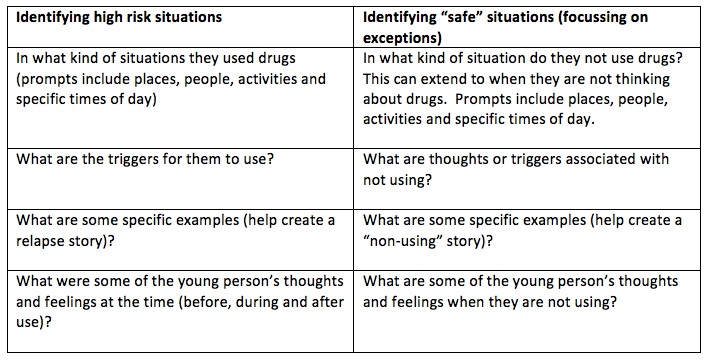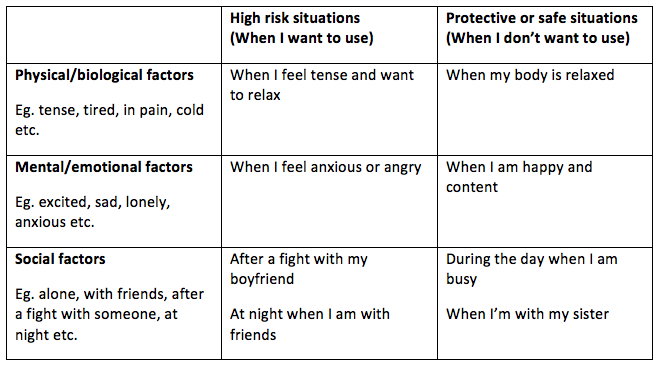Key to relapse prevention is the identification of high risk situations that can lead to unwanted substance use. In general, people use drugs because they perform a function and often are a way of coping when other skills are lacking. High risk situations are unique for each young person and can be influenced by places, people, time of day, activities and feelings that are, or have been associated with substance use. Identifying a young person’s high risk situations is critical for developing relevant relapse prevention plans.
The following questions can encourage the young person to consider their own high risk situations. The focus can be on both factors that can lead to use as well as factors that can keep the young person safe.

Sammy has been in residential detox for 5 days. He is due to go home soon and has already started to identify some of his high risk situations. He has talked about using with friends he met at the train station. He describes specific smells and sounds at the train station that act as triggers for him and he said when he stands at the platform he starts to feel “pumped” at the thought of using. Sammy said when he doesn’t have any money, he catches a bus and this helps avoid his urge to use. He also knows when he goes to basketball training he doesn’t feel like using. There is a specific environment that is strongly associated with Sammy’s using and identifying this and contrasting other environments can help him avoid high risk situations. This will be especially important early after he leaves the detox.
Another approach to identifying and understanding high risk situations is to consider personal and interpersonal factors that can trigger the desire to use. Using a biopsychosocial model, the following factors can be considered in both the context of high-risk situations as well as protective or safe situations:
- Physical states - highly aroused, lethargy or pain
- Emotions – triggers may be pleasant feelings or unpleasant feelings
- Social states - in conflict with others, joyous with others, environmental cues such as the presence of a drug or a certain place
An example of the biopsychosocial model in relapse prevention planning
Working through the biopsychosocial model, Jen identifies the following high-risk and protective factors.

Using this information can help inform targeted relapse prevention plans. It might be helpful to teach Jen some relaxation techniques and encourage her to engage in activities that relax her. It might be there are issues with her boyfriend that can be discussed. What is it about her relationship with her sister that is protective? Can Jen spend more time with her sister? Discovering specific areas of Jen's life can help both her and the practitioner to develop relevant plans.
These types of inquiries can help develop insight and awareness for both the young person and the practitioner about the young person’s use and the consequences using can have. It can also help the practitioner in developing a comprehensive list of high risk situations for the young person that can be noted and observed. Once this has been developed, then the practitioner and young person can work together in creating some strategies to manage high risk situations.
One of the most difficult aspects faced by young people who wish to reduce or abstain from substance use is to find suitable alternatives. It is important that the practitioner and young person discuss together a range of different options available that can act as alternatives to alcohol and other drug use. “The most effective alternatives will be the ones that complement the young person’s abilities, preferences and immediate needs” (YSAS 2002).
D2. ‘Functional analysis’ of alternative behaviours
D7. Activity scheduling & creating opportunities for achievement
